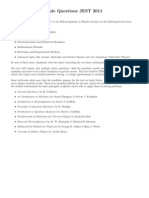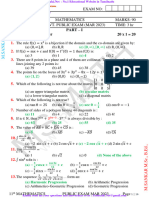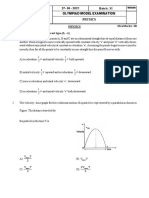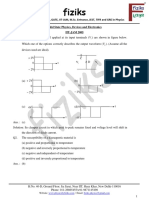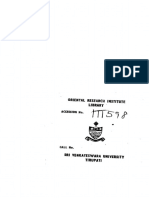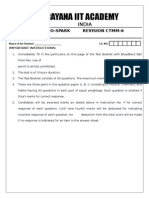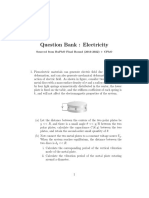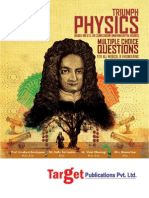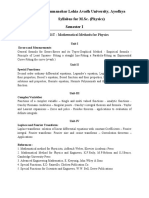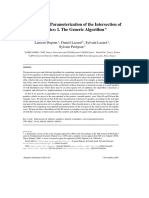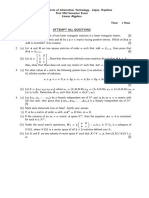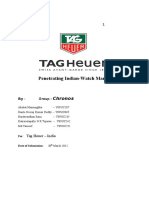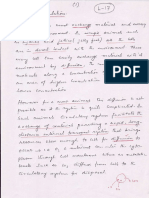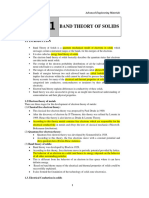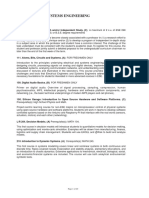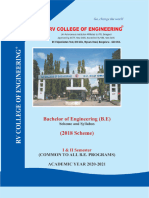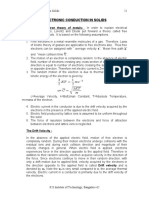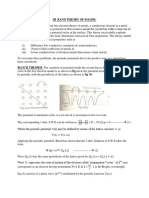Department of Physics - IIT Madras - Syllabus
Department of Physics - IIT Madras - Syllabus
Uploaded by
Tejaswi NisanthCopyright:
Available Formats
Department of Physics - IIT Madras - Syllabus
Department of Physics - IIT Madras - Syllabus
Uploaded by
Tejaswi NisanthOriginal Description:
Original Title
Copyright
Available Formats
Share this document
Did you find this document useful?
Is this content inappropriate?
Copyright:
Available Formats
Department of Physics - IIT Madras - Syllabus
Department of Physics - IIT Madras - Syllabus
Uploaded by
Tejaswi NisanthCopyright:
Available Formats
25/7/2014 Department of Physics :: IIT Madras
http://www.physics.iitm.ac.in/programs/syllabi.php 1/6
M.Sc. Syllabus
Back to M.Sc Program Page
PH 5010 Mathematical Physics
Orthogonal and curvilinear coordinates. Scalar and vector fields, Vector differential operators: gradient, curl. divergence and Laplacian. Vector operators in curvilinear coordinates.
Gauss' theorem. Green's theorem and Stokes' theorem: applications to physical problems. Tensors. Partial differential equations: applications in electrostatics, Laplace and
Poisson equations: heat conduction, diffusion, elastic and electromagnetic waves. Schrodinger wave equation. Solutions in rectangular, spherical polar and cylindrical polar
coordinates. Boundary conditions.
Linear vector spaces and representations. Matrices. Similarity transformations, diagonalization, orthogonality. Hermitian matrices.
Elements of complex variables. Residue theorem and contour integration.
Special functions: Bessel, Hermite, Legendre, Laugerre polynomials: generating functions and orthonormality. Addition theorem for spherical harmonics, application in heat
conduction, diffusion, wave equations etc., Dirac delta function and its representations.
Fourier analysis. Fourier transforms, Laplace transforms and applications in physics.
References :
1. G. Arfken, Mathematical Methods for Physicists. Academic Press. 3rd Edition (1985).
2. I.N. Sneddon, Special Functions of Mathematical Physics and Chemistry, Longman (1980).
3. L.A. Pipes and L.R. Harwill, Applied Mathematics for Physicists and Engineers, McGraw-Hill (1971).
4. P.K. Chattopadhyay, Mathematical Physics, Wiley Eastern (1990)
5. C.R. Wylie and L.C. Barrett. Advanced Engineering Mathematics, 5th Edition, McGraw-Hill (1982).
6. E. Kreyszig, Advanced Engineering Mathematics, Wiley Eastern, Sth Edition (1991 ).
7. M.R. Spiegel in Schaum's outline series, McGraw-Hill (1964). (i) Vector Analysis (ii) Complex Variables (iii) Laplace Transforms (iv) Matrices (v) Differential Equations (vi)
Group Theory.
8. H.Cohen, Mathematics for Scientists and Engineers, Prentice Hall (1992).
PH 5020 Electromagnetic Theory
Electrostatics: Laplace and Poisson equations. Boundary value problems. Dirichlet and Neumann boundary conditions. Method of images. Concept of the Green function and its
use in boundary value problems. Magnetostatics: Ampere's law and Biot-Savart's law. Concept of a vector potential.
Maxwell equations and electromagnetic waves. Maxwell equations (both differential and integral formulations). Boundary conditions on field vectors D, E, B and H. Vector and scalar
potentials. Gauge transformations: Lorentz and Coulomb gauges. Green function for the wave equation. Poynting's theorem. Conservation laws for macroscopic media.
Propagation of plane waves and spherical waves in free space, dielectrics and conducting media. Reflection and refraction of electromagnetic waves. Superposition of waves.
Radiation from an oscillating dipole and radiation from an accelerating charge. Electromagnetic stress tensor.
Wave Guides: Modes in rectangular and cylindrical wave guides (conducting and dielectric). Resonant cavities. Evanescent waves. Energy dissipation. Q of a cavity.
References:
1. J.D. Jackson, Classical Electrodynamics, Wiley Eastern, 2nd Edition (1975).
2. David J. Griffiths, Introduction to Electrodynamics, Prentice Hall of India, 2nd Edition, (1989).
3. J.R. Reitz., F.J. Milford and R. W. Christy, Foundations of Electromagnetic Theory, 3rd Edition, Narosa Pub. House (1979).
4. P. Lorrain and D. Corson, Electromagnetic Fields and Waves. CBS Publishers and Distributors (1986).
5. B.H. Chirgwin, C. Plumpton and C. W. Kilmister, Elementary Electromagnetic Theory, Vols.1, 2 and 3" Pergamon Press (1972).
PH 5030 Classical Mechanics
Mechanics of a system of particles in vector form. Conservation of linear momentum, energy and angular momentum. Degrees of freedom, generalised coordinates and velocities.
Lagrangian, action principle, external action, Euler-Lagrange equations. Constraints. Applications of the Lagrangian formalism. Generalised momenta, Hamiltonian, Hamilton's
Home People Research Programs Events Resources Contact
25/7/2014 Department of Physics :: IIT Madras
http://www.physics.iitm.ac.in/programs/syllabi.php 2/6
equations of motion. Legendre transform, relation to Lagrangian formalism. Phase space, Phase trajectories. Applications to systems with one and two degrees of freedom.
Central force problem, Kepler problem, bound and scattering motions. Scattering in a central potential, Rutherford formula, scattering cross section.
Noninertial frames of reference and pseudoforces: centrifugal Coriolis and Euler forces. Elements of rigid-body dynamics. Euler angles. The symmetric top. Small oscillations
Normal mode analysis. Normal modes of a harmonic chain.
Elementary ideas on general dynamical systems: conservative versus dissipative systems. Hamiltonian systems and Liouville's theorem. Canonical transformations, Poisson
brackets. Action-angle variables. Non-integrable systems and elements of chaotic motion.
Special relativity: Internal frames. Principle and postulate of relativity. Lorentz transformations. Length contraction, time dilation and the Doppler effect. Velocity addition formula. Four-
vector notation. Energy-momentum four-vector for a particle. Relativistic invariance of physical laws.
References :
1. H. Goldstein, Classical Mechanics, 2nd Edition, Narosa Pub. House (1989).
2. I. Percival and D. Richards, Introduction to Dynamics, Cambridge University Press ( 1987) [Chapters 4,5,6, 7 in particular. also parts of Chapter 1-3,9, 10].
3. D. Rindler, Special Theory of Relativity, Oxford University Press (1982).
PH 5040 Electronics
Introduction to Integrated Circuits
Differential amplifiers using Transistors
Operational amplifiers
Features
Characteristics
Negative feedback configurations
Mathematical operations application circuits
Non-linear applications
Comparator
Window comparator
Regenerative comparator
Relaxation oscillator
Log and Antilog amplifiers
Multiplier, square and square-root circuits
NE555, principle of operation and applications
Introduction to Digital logic gates
Combinational circuits
Reduction using Karnaugh map
Implementation using universal gates
Arithmetic circuits
Look-ahead carry implementation
Binary BCD addition
Decoders and encoders
Multiplexers and demultiplexers their applications
Flip-flops, types and implementation
Conversions, triggering, master/slave implementation
Registers
Binary up down counters
Synchronous counters
Ring and Johnson counters
Random sequence generators
7-segment display devices
A to D and D to A converters
Applications of digital circuits
Digital clock, stop-watch, frequency and period counter, digital voltmeter etc.
25/7/2014 Department of Physics :: IIT Madras
http://www.physics.iitm.ac.in/programs/syllabi.php 3/6
Introduction to microprocessors
Brief outline of 8085 processor
Instruction set
Simple programming examples
Pick the largest number
Delay
Arithmetic operation with single and multiyear
Block move with overlapping memory address
Ascending and descending ordering
Test Books:
1. Electronic Principles 5th Edition, Albert Paul Malvino
Tana Mc-Graw-Hill Publishing Company Ltd., New Delhi, 1993
2. Digital Principles and Applications 5th Edition
Albert Paul Malvino Donald P.Lcach
Tana Mc-Graw-Hill Publishing Company Ltd., New Delhi, 1994
3. Microprocessor Architecture, Programming and its Applications with the 8-85/8080A latest edition,
5th edition Ramesh S.Gaonkar
Wiley Eastern Ltd., New Delhi, Bangalore, Madras. , 2002
4. Digital Fundamentals 9th edition,
Thomas L.Floyd,
Prentice Hall, July 13, 2005
5. Digital Design 3rd edition,
M.Morris Mano
Prentice Hall, 2001
6. Digital Design 4th edition,
M.Morris Mano
Prentice Hall, 2006.
PH 5080 Statistical Physics
Systems with a very large number of degrees of freedom: the need for statistical mechanics. Macrostates, microstates and accessible microstates. Fundamental postulate of
equilibrium statistical mechanics.
Probability distributions. Microcanonical ensemble, Boltzmann's formula for entropy. Canonical ensemble, partition function, free energy. calculation of thermodynamic quantities.
Classical ideal gas. Maxwell-Boltzmann distribution, equipartition theorem. Paramagnetism, Langevin and Brillouin functions, Curie's law.
Quantum statistics: systems of identical, indistinguishable particles, spin, symmetry of wavefunctions, bosons, Pauli's exclusion principle, fermions. Grand canonical ensemble.
Bose-Einstein and Fermi-Dirac distributions. Degeneracy. Free electron gas, Pauli paramagnetism. Blackbody radiation. Bose-Einstein condensation. Einstein model of lattice
vibrations. phonons, Debye's theory of the specific heat of crystals.
Phase diagrams, phase equilibria and phase transitions. Mean-fjeld theory of liquid-gas transition (Van der Waals model) and ferromagnet-paramagnet transition (Weiss'
molecular field theory). Heisenberg exchange interaction and the origin of ferromagnetism. Elementary ideas on Ising and Heisenberg models of ferromagnetism.
References:
1. D. Chandler, Introduction to Modern Statistical Mechanics, Oxford University press (1987).
2. C.J. Thompson, Equilibrium Statistical Mechanics, Clarendon Press (1988).
3. F. Reif, Fundamentals of Statistical and Thermal Physics, International Student Edition, McGraw-Hill (1988).
4. K. Huand, Statistical Mechanics, IJ\Iiley Eastern (1988).
5. L.D.. Landau and E.M. Lifshitz, Statistical Physics (Par1I), 3rd Edition, Pergamon Press ( 1989).
6. F. Reif, Statistical Physics (Berkeley Physics Course, Vol.5), McGraw Hill (1967).
7. F. Mandl, Statistical Physics, 2nd edition, ELBS & Wiley (1988)
8. E.S.R. Gopal, Statistical Mechanics and Properties of Matter MacMillan India (1988).
9. R. Kubo. Statistical Physics -Problems and Solutions, North Holland (1965).
10. Y.K. Lim, Problems and Solutions in Thermodynamics and Statistical Mechanics, World Scientific (1990).
PH 5100 Quantum Mechanics-I
Basic principles of quantum mechanics. Probabilities and probability amplitudes. Linear vector spaces. Bra and ket vectors. Completeness, orthonormality, basis sets. Change of
basis. Eigenstates and eigenvalues. Position and momentum representations. Wavefunctions, probability densities, probability current. Schrodinger equation. Expectation values.
Generalized uncertainty relation.
One dimensional potential problems Particle in a box. Potential barriers. Tunnelling.
Linear harmonic oscillator: wavefunction approach and operator approach.
25/7/2014 Department of Physics :: IIT Madras
http://www.physics.iitm.ac.in/programs/syllabi.php 4/6
Motion in three dimensions. Central potential problem. Orbital angular momentum operators. Spherical harmonics. Eigenvalues of orbital angular momentum operators.
The hydrogen atom and its energy eigenvalues.
Charged particle in a uniform constant magnetic field, energy eigenvalues and eigenfunctions. Schrodinger and Heisenberg pictures Heisenberg equation of motion. Interaction
picture.
Semiclassical approximation: the WKB method
Time-independent perturbation theory. Nondegenerate and degenerate cases. Examples.
Time-dependent perturbation theory. Transition probabilities. Sudden and adiabatic approximations. Fermi golden rule.
The variational method: simple examples.
References:
1. E. Merzbacher, Quantum Mechanics, 2nd Edition, Wiley International Edition (1970).
2. V.K. Thankappan, Quantum Mechanics. Wiley Eastern (1985)
3. J.J. Sakurai, Modern Quantum Mechanics, Benjamin Cummings (1985).
4. R.P. Feynman, R.B. Leighton and M.Sands, The Feynman Lectures on Physics, Vol.3, Narosa Pub. House (1992).
5. P.M. Mathews and K. Venkatesan, A Textbook of Quantum Mechanics, Tata McGraw-Hill (1977).
PH 5110 Optics
Geometric optics: Eikonal equations, Fermat's principle and appications to laws of reflection and refraction. Parseval optics, ABCD matrix description of lenses, mirrors, etc.
Aberrations: Wavefront aberration coefficients, Transverse ray coefficients, spherical aberration, coma, astigmatism, field curvature, distortions and aberration reduction.
Dispersion: phase and group velocity, material dispersion, normal and anomalous dispersion, chromatic aberration.
Fourier techniques: Fourier analysis, Fourier transforms, diffraction of light, Fourier transformation by propagation, lenses and their description in Fourier transformation and
imaging. Spread functions, modulation transfer functions, convolution, etc.
Diffraction theory of image formation, optical data processing, Coherence, classical coherence functions, autocorrelation function and time coherence. Spatial coherence, mutual
coherence functions, visibility of fringes.
Crystal optics: double refraction. Polarization and anisotropy of wave propagation in crystals, dielectric and optical indicatrix, uniaxial and biaxial crystals.
Nonlinear optics susceptibility tensor and wave propagation in nonlinear media.
Waveguide optics: propogation and dispersion in cylindrical and planar waveguides.
References:
1. Max Born and Emil Wolfe, Principles of Optics, Pergamon Press, 6th Edition (1985).
2. M.V. Klein and T.E. Furtak, Optics, 2nd edition, John Wiley (1986).
3. R.S. Sirohi, Wave Optics and Applications, Orient Longman (1992)
4. A.K. Ghatak and K. Thyagarajan, Contemporary Optics, Plenum Pub. Co. (1978).
5. J.R. Mayer-Arendt M.D. Introduction to Classical and Modern Optics, 2nd Edition, Prentice Hall (1988).
6. R.S. Sirohi and M.P. Kothiyal, Optical Components, Systems and Measurement Techniques, Marcell Dekker (1991 ).
7. R.D Guenther, Modern Optics, John Wiley (1990)
8. P. Hariharan, Optical Holography, Cambridge University Press (1984).
9. D. Casasent, (ed), Optical Data Processing, Springer Verlag (1978).
PH 5120 Physics Laboratory -II
Arc spectra: analysis of line and band spectra
G.M. counter
Curie temperature
Millikan's oil drop method: electron charge
Velocity of ultrasonic waves in liquids (a) by diffraction (b) by inteferometer.
Twyman-Green interferometer.
Fourier transform processor.
Hall effect. Scintillation counter.
X-ray powder photograph
Magnetostriction Thermal expansion: Fizeau's method
Latent heat of liquid nitrogen. Absorption spectrum of colour centers
spectrophotomerter.
References:
25/7/2014 Department of Physics :: IIT Madras
http://www.physics.iitm.ac.in/programs/syllabi.php 5/6
Worsnop and Flint, Advanced Practical Physics for Students Methusen & Go. (1950).
E.V. Smith, Manual for Experiments in Applied Physics. Butterworths (1970).
R.A. Dunlap, Experimental Physics: Modern Methods, Oxford University Press (1988).
D. Malacara (ed), Methods of Experimental Physics, Series of Volumes, Academic Press Inc. (1988).
PH 5160 Condensed Matter Physics-I
Classification of condensed matter: crystalline, noncrystalline, nanophase solids, liquids. Crystalline solids: Bravais lattices, crystal systems, point groups, space groups and
typical structures.
Crystal symmetry and macroscopic physical properties: tensors of various ranks: pyroelectricity, ferroelectricity, electrical conductivity, piezoelectricity and elasticity tensors.
Propagation of elastic waves in crystals and measurement of elastic constants.
Diffraction of waves by crystals: X-rays, neutrons, electrons. Bragg's law in direct and reciprocal lattice. Structure factor. Principles of diffraction techniques. Brillouin zones.
Types of binding. Ionic crystals: Born Mayer potential. Thermochemical Bom-Haber cycle. Van der Waals binding: rare gas crystals and binding energies. Covalent and metallic
binding: characteristic features and examples.
Lattice dynamics: monoatomic and diatomic lattices. Born-von Karman method. Phonon frequencies and density of states. Dispersion curves, inelastic neutron scattering.
Reststrahlen Specific heat. Thermal expansion. Thermal conductivity. Normal and Umklapp processes.
Free electron theory of metals. Thermal and transport properties. Hall effect Electronic specific heat.
Bloch functions. Nearly free electron approximation. Formation of energy bands. Gaps at Brillouin zone boudaries. Electron states and classification into insulators, conductors and
semimetals. Effective mass and concept of holes. Fermi surface. Cyclotron resonance.
Semiconductors: carrier statistics in intrinsic and extrinsic crystals, electrical conductivity. Liquid crystal: thermotropic and lyotropic. Nematics and sematics: applications.
Amorphous/glassy states.
References:
1. Charles Kittel, Introduction to Solid State Physics, Wiley, 5th Edition ( 1976).
2. A.J. Dekker. Solid State Physics, Prentice Hall, (1957)
3. N.W. Ashcroft and N.D. Mermin, Solid State Physics, Saunders College Publishing (1976).
4. J.S. Blakemore,Solid State Physics, 2nd Edition, Cambridge University Press. (1974).
5. Mendel Sachs, Solid State Theory, McGraw-Hill (1963)
6. Harald bach and Hans Luth, Solid-State Physics, Springer International Student Edition, Narosa Pub. House, (1991).
PH 5170 Quantum Mechanics-II
Orbital and spin angular momentum. Angular momentum algebra. Eigenstates and eigenvalues of angular momentum. Addition of angular momenta, Clebsch-Gordon coefficients.
Irreducible tensor operators and the Wigner-Eckart theorem.
Systems of identical particles. Symmetric and antisymmetric wavefunctions. Bosons and Fermions. Pauli's exclusion principle. Second quantization, occupation number
representation.
Non-relativistic scattering theory. Scattering amplitude and cross- section. The integral equation for scattering. Born approximation. Partial wave analysis. The optical theorem.
Elements of relativistic quantum mechanics. The Klein-Gordon equation. The Dirac equation. Dirac matrices, spinors. Positive and negative energy solutions, physical
interpretation. Nonrelativistic limit of the Dirac equation.
References:
1. J.J. Sakurai Modern Quantum Mechanics, Benjamin / Cummings (1985).
2. P.A.M. Dirac, The Principles of Quantum Mechanics, Oxford University Press (1991 ).
3. L.D.Landau and E.M. Lifshitz, Quantum Mechanics -Nonrelativistic Theory, 3rd Edition, Pergamon (1981 ).
4. P.M. Mathews and K. Venkatesan, A Textbook of Quantum Mechanics, Tata McGraw-Hill (1977).
5. J. Bjorken and S. Drell, Relativistic Quantum Mechanics, McGraw-Hill (1965).
6. A. Messiah, Quantum Mechanics, Vols. 1 and 2, North Holland (1961 )
PH 5210 Condensed Matter Physics -II
Internal electric field in a dielectric. Clausius-Mossotti and Lorentz-Lorenz equations. Point dipole, deformation dipole and shell models. Dielectric dispersion and loss.
Ferroelectrics: types and models of ferro electric transition.
Diamagnetic susceptibility. Quantum theory of paramagnetism. Transition metal ions and rare earth ions in solids. Crystal field effect and orbital quenching. Ferromagnetic and
antiferromagnetic ordering. Curie-Weiss theory, Heisenberg theory, Curie and Neel temperatures. Domain walls, Spin waves and magnon dispersion.
Optical properties of solids: band to band absorption, excitons. polarons. Colour centres. Luminescence. Photoconductivity. Point defects: Thermodynamics of point defects. Frenkel
and Schottky defects. Formation enthalpies. Diffusion and ionic conductivity. Superionic materials.
25/7/2014 Department of Physics :: IIT Madras
http://www.physics.iitm.ac.in/programs/syllabi.php 6/6
Extended defects: dislocations, models of screw and edge dislocations. Burgers vector. Stress field around dislocations, interaction between dislocations with point defects. Work
hardening.
Superconductivity, experimental and theoretical aspects, new materials and models.
Referenes:
1. Charles Kittel, Introduction to Solid State Physics, Wiley, 5th Edition, (1976).
2. A.J. Dekker, Solid State Physics, Prentice Hall (1957).
3. N.W. Ashcroft and N.D. Mermin, Solid State Physics, Saunders College Publishing (1976).
4. J.S. Blakemore, Solid State Physics, 2nd Edition, Cambridge University Press, (1974).
5. Mendel Sachs, Solid State Theory, McGraw-Hill (1963).
6. A.O.E. Animalu, Intermediate Quantum Theory of Solids, Prentice Hall (1977).
PH 6110 Classical Field Theory
Lorentz transformations: infinitesimal generators, metric tensors, the light cone. Contravariant and covariant vectors and tensors.
Classical field theory of a real scalar field: action, Lagrangian density, Euler-Lagrange field equation. The conjugate momentum. Hamiltonian density, energy-momentum tensor,
physical interpretation .
Angular momentum tensor for a real scalar field. Invariance under Lorentz transformations and conservation of angular momentum. Internal degrees of freedom and
symmetrization of the energy-momentum tensor.
complex scalar field :Lagrangian, field equations, global field invarience.
Noether's theorem: transformations, invariance and conserved quantities. Translations, rotations, Lorentz and gauge transformations as illustrations.
The mass less vector field: Lagrangian, field equations, Lorentz condition. The field tensor, Maxwell's equations. Energy density, Poynting vector. Invariance of the electromagnetic
field. Lorentz transformation properties of electric and magnetic fields. Minimal coupling of matter fields to the electromagnetic field. Covariant derivative, local gauge invariance,
continuity equation for the current, charge conservation.
General covariance. Curved space, metric tensor, connection, parallel transport, covariant derivative, curvature tensor. Principle of equivalence. Gravitational field equations.
References:
1. L.D. Landau and E.M. Lifshitz, The Classical Theory of Fields, 4th Edition, Pergamon (1975).
2. M.R. Spiegel. Vector Analysis, Schaum Outline Series, McGraw-Hill (1974).
3. M. Carmeli, Classical Fields, Wiley (1982).
4. A.O. Barut, Electrodynamics and Classical Theory of Fields, Chapter 1, MacMillan (1986).
5. C. Itzykson and J.8. Zuber, Quantum Field Theory, International Student Edition, Chapter 1 (1986).
Back to M.Sc Program Page
You might also like
- Solid State Physics by J P Shrivastav PDFDocument615 pagesSolid State Physics by J P Shrivastav PDFKishan Prajapati83% (6)
- R. J. Singh - Solid State Physics-Pearson Education (2011)Document609 pagesR. J. Singh - Solid State Physics-Pearson Education (2011)saisasikumar26No ratings yet
- B.SC 2nd and 3rd Year Syllabus SVUDocument16 pagesB.SC 2nd and 3rd Year Syllabus SVUSrinivasulu Pudu100% (1)
- Seethamma MaayammaDocument3 pagesSeethamma MaayammaTejaswi NisanthNo ratings yet
- Kronig Penny Model: Engineering Physics by Dr. Amita Maurya, Peoples University, Bhopal. Unit 5Document7 pagesKronig Penny Model: Engineering Physics by Dr. Amita Maurya, Peoples University, Bhopal. Unit 5Wulandari PrimaNo ratings yet
- Jest Physics Sample Question PaperDocument3 pagesJest Physics Sample Question PaperSreejith Nhaloor0% (1)
- Aryabhatt A The Great AstronomerDocument55 pagesAryabhatt A The Great AstronomerSachin RathodNo ratings yet
- Kronig-Penney Model (Condensed Matter Assignment)Document3 pagesKronig-Penney Model (Condensed Matter Assignment)Ana SalimenNo ratings yet
- Indian Association of Physics Teachers: National Graduate Physics Examination 2021Document8 pagesIndian Association of Physics Teachers: National Graduate Physics Examination 2021Akshay Kumar100% (1)
- Bharati Krsna Tirthaji, V. S. Agrawala (Editor) - Vedic Mathematics - Sixteen Simple Mathematical Formulae From The Vedas-Motilal Books (1970)Document424 pagesBharati Krsna Tirthaji, V. S. Agrawala (Editor) - Vedic Mathematics - Sixteen Simple Mathematical Formulae From The Vedas-Motilal Books (1970)PMG Bhuswal ProjectNo ratings yet
- 11th Maths EM Answer Keys To Public Exam March 2023 Original Question Paper English Medium PDF Download 1Document16 pages11th Maths EM Answer Keys To Public Exam March 2023 Original Question Paper English Medium PDF Download 1roshinid2018No ratings yet
- ARYABHATADocument2 pagesARYABHATAVikas Dahiya100% (1)
- Ramanujan's National Mathematics Competition - BrochureDocument2 pagesRamanujan's National Mathematics Competition - BrochureSridevi KuntamukalaNo ratings yet
- HPSC AP Physics 2016Document27 pagesHPSC AP Physics 2016SAHIN Inspire100% (1)
- National Standard Exam in Physics - 2010 Question PaperDocument8 pagesNational Standard Exam in Physics - 2010 Question PaperPrateet Narayan RathNo ratings yet
- PH Ysicsguide: MagnetostaticsDocument46 pagesPH Ysicsguide: MagnetostaticsRithish Barath100% (1)
- Physics ProblemsDocument69 pagesPhysics ProblemsRamon Castañer BotellaNo ratings yet
- Nit Patna Academic CalendarDocument3 pagesNit Patna Academic CalendarAnurag BaidyanathNo ratings yet
- 9TH ClassDocument54 pages9TH ClassUmme AbdullahNo ratings yet
- Jee-Main - GTM (Only 2nd Yr Syllabus)Document1 pageJee-Main - GTM (Only 2nd Yr Syllabus)Sameena Loni100% (1)
- Csir QDocument86 pagesCsir QVineet SinghNo ratings yet
- Matrices Determinants Xii PDFDocument18 pagesMatrices Determinants Xii PDFRishabhNo ratings yet
- Brilliant: Physics Olympiad Model ExaminationDocument9 pagesBrilliant: Physics Olympiad Model ExaminationKalyani BaijuNo ratings yet
- Physics Notes Class 9: Phase 1 CHAPTER (1to5)Document77 pagesPhysics Notes Class 9: Phase 1 CHAPTER (1to5)Nasir SaleemNo ratings yet
- NSEA 2018 Qs and Soln 1Document32 pagesNSEA 2018 Qs and Soln 1Rajdeep Nandy100% (1)
- Disha Publication Trend Analysis For Jee Main P.C.M. V526057554Document3 pagesDisha Publication Trend Analysis For Jee Main P.C.M. V526057554Kumar Shivesh100% (1)
- Emch - Sridharan - Srinivas - Contributions Ot The History of Indian Mathematics (2005)Document285 pagesEmch - Sridharan - Srinivas - Contributions Ot The History of Indian Mathematics (2005)riddajeenNo ratings yet
- Solid State Physics, Devices and Electronics PDFDocument34 pagesSolid State Physics, Devices and Electronics PDFGorachand DasNo ratings yet
- ICSE Solutions For Class 9 History and Civics - The Age of The GuptasDocument26 pagesICSE Solutions For Class 9 History and Civics - The Age of The GuptasleenaapNo ratings yet
- CBSe Tips For PreparationsDocument17 pagesCBSe Tips For PreparationsPraveenNo ratings yet
- Aakanksha Sarda : Delhi India Croatia Massachusetts Institute of TechnologyDocument3 pagesAakanksha Sarda : Delhi India Croatia Massachusetts Institute of TechnologyvinayNo ratings yet
- Bhāskara II: Bhāskara (1114-1185) Also Known As Bhāskarāchārya ("BhāskaraDocument10 pagesBhāskara II: Bhāskara (1114-1185) Also Known As Bhāskarāchārya ("BhāskaracrppypolNo ratings yet
- Sambodhi 2000 PDFDocument157 pagesSambodhi 2000 PDFManik JainNo ratings yet
- Abstract Algebra Assignment SolutionDocument12 pagesAbstract Algebra Assignment SolutionStudy With MohitNo ratings yet
- BSC4YearSystem PDFDocument19 pagesBSC4YearSystem PDFBloom NepalNo ratings yet
- IOQA-2022-23 - (Answers & Solutions)Document16 pagesIOQA-2022-23 - (Answers & Solutions)Akshay TiwariNo ratings yet
- Book To Be Followed For ISI MDocument10 pagesBook To Be Followed For ISI Mp1v1nNo ratings yet
- Mathematical Methods Unit - IDocument2 pagesMathematical Methods Unit - IMr. CuriousNo ratings yet
- 10-01-15 SR - Iit-Z (Iz) Co-Spark Jee Main Ctm-6 Q'paperDocument29 pages10-01-15 SR - Iit-Z (Iz) Co-Spark Jee Main Ctm-6 Q'paperazeem100% (2)
- 124 Physics Question Bank - 7 For Class X 20190913104019Document2 pages124 Physics Question Bank - 7 For Class X 20190913104019HARRY POTTERNo ratings yet
- MSC PhysicsDocument22 pagesMSC PhysicsYay GautamNo ratings yet
- ICSE Solutions For Class 10 Geography - Map Study - Interpretation and Topographical Maps - A Plus TopperDocument44 pagesICSE Solutions For Class 10 Geography - Map Study - Interpretation and Topographical Maps - A Plus ToppervikashNo ratings yet
- MHT Cet Question Papers With Answer KeysDocument35 pagesMHT Cet Question Papers With Answer KeysVaishakh VarierNo ratings yet
- A Inao 01-06Document53 pagesA Inao 01-06NiZamMAdridistaNo ratings yet
- PH Ysicsguide: Basic Postulates of QMDocument32 pagesPH Ysicsguide: Basic Postulates of QMRithish Barath100% (1)
- 11th Physics Vol.2 Model Question Paper English Medium 1 PDFDocument4 pages11th Physics Vol.2 Model Question Paper English Medium 1 PDFc.sujithNo ratings yet
- Complete Physics Book NotesDocument223 pagesComplete Physics Book Notesmbamando4No ratings yet
- Physics AssignmentDocument22 pagesPhysics AssignmentVeerareddy Vippala100% (1)
- Assignment 8Document9 pagesAssignment 8vidhya dsNo ratings yet
- Fiitjee All India Test Series: JEE (Advanced) - 2020Document16 pagesFiitjee All India Test Series: JEE (Advanced) - 2020Yogesh Kumar PandeyNo ratings yet
- Electricity Question Bank-1Document15 pagesElectricity Question Bank-1Sahibnoor SinghNo ratings yet
- (2087) Lecture Notes 1 Atomic Structure eDocument53 pages(2087) Lecture Notes 1 Atomic Structure eRamJiPandeyNo ratings yet
- INSP CHAMPS 2022 THERMODYNAMICS FinalDocument20 pagesINSP CHAMPS 2022 THERMODYNAMICS FinalSubham KumarNo ratings yet
- Indian National Physics Olympiad - 2014: Question Paper & SolutionsDocument8 pagesIndian National Physics Olympiad - 2014: Question Paper & SolutionsTanmyaNo ratings yet
- NSEJS 2013 Paper SolutionsDocument6 pagesNSEJS 2013 Paper SolutionsDr Mohan SavadeNo ratings yet
- WORK, POWER, ENERGY & MOMENTUM Important QuestionsDocument18 pagesWORK, POWER, ENERGY & MOMENTUM Important QuestionsRavindra KumarNo ratings yet
- Xii Neet Physics Mcqs PDFDocument49 pagesXii Neet Physics Mcqs PDFAnand ClassesNo ratings yet
- MSC Program SyllabusDocument11 pagesMSC Program Syllabuscneha4724No ratings yet
- MSC TZPDocument12 pagesMSC TZPParagjyoti SutNo ratings yet
- BSC Physics Hon 482010Document64 pagesBSC Physics Hon 482010Venugopal ReddyvariNo ratings yet
- Post-Graduate Syllabus: Department of PhysicsDocument38 pagesPost-Graduate Syllabus: Department of PhysicsBikash DeyNo ratings yet
- .5 Physics Core Courses PHY101: Mechanics (Cr:3, Lc:2, Tt:1, Lb:0) Course OutlineDocument5 pages.5 Physics Core Courses PHY101: Mechanics (Cr:3, Lc:2, Tt:1, Lb:0) Course OutlineDaljot KangNo ratings yet
- PhysicsDocument26 pagesPhysicsAbhinandanNo ratings yet
- Limit by MMSR SirDocument2 pagesLimit by MMSR SirTejaswi NisanthNo ratings yet
- Green Information TechnologyDocument14 pagesGreen Information TechnologyTejaswi NisanthNo ratings yet
- Near-Optimal Parameterization of The Intersection of Quadrics: I. The Generic Algorithm ?Document23 pagesNear-Optimal Parameterization of The Intersection of Quadrics: I. The Generic Algorithm ?Tejaswi NisanthNo ratings yet
- Explorations in Nanophotonics-6: The Left Is Sometimes Right!Document2 pagesExplorations in Nanophotonics-6: The Left Is Sometimes Right!Tejaswi NisanthNo ratings yet
- Linear Algebra: N×N N×NDocument1 pageLinear Algebra: N×N N×NTejaswi NisanthNo ratings yet
- Nature and Scope of CommunicationDocument18 pagesNature and Scope of CommunicationTejaswi Nisanth100% (1)
- TAG Huer - Report-2fDocument12 pagesTAG Huer - Report-2fTejaswi NisanthNo ratings yet
- HeartDocument22 pagesHeartTejaswi NisanthNo ratings yet
- Letter Writing 1Document13 pagesLetter Writing 1Tejaswi NisanthNo ratings yet
- BANTUREETHI KOLU Hamsanaadam Adi ThyagarajaDocument3 pagesBANTUREETHI KOLU Hamsanaadam Adi ThyagarajaTejaswi NisanthNo ratings yet
- LA3Document2 pagesLA3Tejaswi NisanthNo ratings yet
- Quick Latex Tutorial: Rolando V. Raqueño Sunday, January 17, 2016Document44 pagesQuick Latex Tutorial: Rolando V. Raqueño Sunday, January 17, 2016Tejaswi NisanthNo ratings yet
- Part I: Atomic and Molecular SpectrosDocument3 pagesPart I: Atomic and Molecular SpectrosTejaswi NisanthNo ratings yet
- PG PhysicsDocument33 pagesPG PhysicsAMIT VAIDNo ratings yet
- Free Electron ModelDocument11 pagesFree Electron Modelshaikh gaushiyaNo ratings yet
- Unit I - Band Theory of Solids NotesDocument28 pagesUnit I - Band Theory of Solids Notesmirae kangNo ratings yet
- BS Applied Physics CourseoutlineDocument22 pagesBS Applied Physics CourseoutlineSyed JunaidNo ratings yet
- Quantum Theory of SolidsDocument12 pagesQuantum Theory of SolidsMeghana Chowdary ArumilliNo ratings yet
- HCI H3 PHY 9811 EoMP QP PDFDocument12 pagesHCI H3 PHY 9811 EoMP QP PDFLeng RyanNo ratings yet
- EseDocument20 pagesEseAndrea NingNo ratings yet
- Griffiths 5.15 16 17 18Document4 pagesGriffiths 5.15 16 17 18Tom smithNo ratings yet
- First Year 2018 Scheme Scheme & Syllabus 18 Dec 2020Document39 pagesFirst Year 2018 Scheme Scheme & Syllabus 18 Dec 2020princedinakar15No ratings yet
- Free Electron TheoryDocument17 pagesFree Electron TheoryBijay SharmaNo ratings yet
- KUD M.sc. Physics Syllabus - 2022-FinalDocument93 pagesKUD M.sc. Physics Syllabus - 2022-Finalvijay405513No ratings yet
- EP3220 Quiz 2 2024 Solution 2Document6 pagesEP3220 Quiz 2 2024 Solution 2ep21b004No ratings yet
- 5.2 Electron Theory of MetalsDocument9 pages5.2 Electron Theory of MetalsSrî HárshàNo ratings yet
- Ioniz PDFDocument3 pagesIoniz PDFSyed Raza Ali RazaNo ratings yet
- Electrical ConductivityDocument19 pagesElectrical ConductivityMahesh Lohith K.S80% (5)
- 22 Scheme Physics For Eee Module 2 NotesDocument33 pages22 Scheme Physics For Eee Module 2 Notessnehashiragannavar773No ratings yet
- Optoelectronic Materials and DevicesDocument16 pagesOptoelectronic Materials and DevicesMar'i MuchammadNo ratings yet
- VNR Vignana Jyothi Institute of Engineering & Technology Hyderabad B.Tech. I Year (Electrical and Electronics Engineering) I Semester R19Document36 pagesVNR Vignana Jyothi Institute of Engineering & Technology Hyderabad B.Tech. I Year (Electrical and Electronics Engineering) I Semester R19Bhanuteja KorutlaNo ratings yet
- r05010201 Applied PhysicsDocument4 pagesr05010201 Applied PhysicsSRINIVASA RAO GANTANo ratings yet
- R19 Physics UNIT-3 JNTUKDocument20 pagesR19 Physics UNIT-3 JNTUKVijayNo ratings yet
- Wiedemann-Franz Law PDFDocument3 pagesWiedemann-Franz Law PDFArunraj KasiNo ratings yet
- Solid State Physics-2Document183 pagesSolid State Physics-2Tauseef AhmadNo ratings yet
- GJU B. Tech. Syllabus For Mechanical EngineeringDocument197 pagesGJU B. Tech. Syllabus For Mechanical EngineeringHimanshuNo ratings yet
- ELK364E Lecture 1 ConductivityDocument64 pagesELK364E Lecture 1 ConductivitySemih YILDIRIMNo ratings yet
- BSC III Sem VIDocument3 pagesBSC III Sem VIrushiNo ratings yet
- Energy Levels in One DimensionDocument13 pagesEnergy Levels in One DimensionSaiia GusttiNo ratings yet





